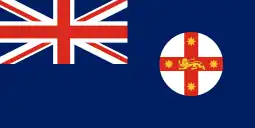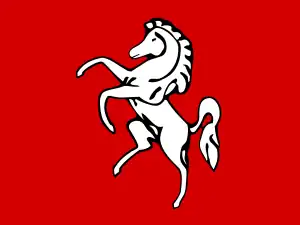Portal maintenance status: (June 2018)
|
The New South Wales Portal
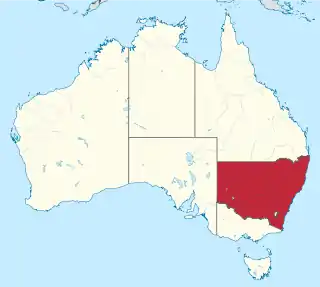
New South Wales (commonly abbreviated as NSW) is a state on the east coast of Australia. It borders Queensland to the north, Victoria to the south, and South Australia to the west. Its coast borders the Coral and Tasman Seas to the east. The Australian Capital Territory and Jervis Bay Territory are enclaves within the state. New South Wales' state capital is Sydney, which is also Australia's most populous city. , the population of New South Wales was over 8 million, making it Australia's most populous state. Just under two-thirds of the state's population, 5.3 million, live in the Greater Sydney area.
The Colony of New South Wales was founded as a British penal colony in 1788. It originally comprised more than half of the Australian mainland with its western boundary set at 129th meridian east in 1825. The colony then also included the island territories of Van Diemen's Land, Lord Howe Island, and Norfolk Island. During the 19th century, most of the colony's area was detached to form separate British colonies that eventually became the various states and territories of Australia. However, the Swan River Colony was never administered as part of New South Wales. (Full article...)
 Recognized content -
Recognized content - 
 Image 1
Image 1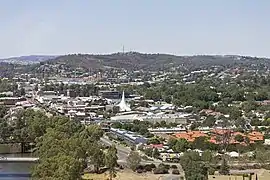 An aerial view of central Wagga Wagga
An aerial view of central Wagga Wagga
Wagga Wagga (/ˌwɒɡə ˈwɒɡə/; informally called Wagga) is a major regional city in the Riverina region of New South Wales, Australia. Straddling the Murrumbidgee River, with an urban population of more than 71,241 as of 2023, Wagga Wagga is the state's second largest inland city after Maitland, and is an important agricultural, military, and transport hub of Australia. The ninth largest inland city in Australia, Wagga Wagga is located midway between the two largest cities in Australia—Sydney and Melbourne—and is the major regional centre for the Riverina and South West Slopes regions.
The central business district is focused around the commercial and recreational grid bounded by Best and Tarcutta Streets and the Murrumbidgee River and the Sturt Highway. The main shopping street of Wagga is Baylis Street which becomes Fitzmaurice Street at the northern end. Wagga is accessible from Sydney via the Sturt and Hume Highways, Adelaide via the Sturt Highway and Albury and Melbourne via the Olympic Highway and Hume Highway. Wagga is in an alluvial valley and much of the city has a problem with urban salinity. (Full article...) Image 2
Image 2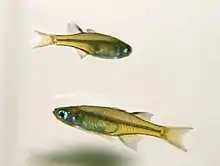
The Pacific blue-eye (Pseudomugil signifer) is a species of fish in the subfamily Pseudomugilinae native to eastern Australia. Described by Austrian naturalist Rudolf Kner in 1866, it comprises two subspecies that have been regarded as separate species in the past and may be once again with further study. It is a common fish of rivers and estuaries along the eastern seaboard from Cape York in North Queensland to southern New South Wales, the Burdekin Gap in central-north Queensland dividing the ranges of the two subspecies.
A small silvery fish averaging around 3.25 cm in total length (1+1⁄8–1+3⁄8 in), the Pacific blue-eye is recognisable by its blue eye-ring and two dorsal fins. It forms loose schools of tens to thousands of individuals. It eats water-borne insects as well as flying insects that land on the water's surface, foraging for them by sight. The Pacific blue-eye adapts readily to captivity. (Full article...) Image 3
Image 3.jpg.webp)
Edward Pulsford (29 September 1844 – 29 September 1919) was an English-born Australian politician and free-trade campaigner.
Pulsford established a successful business with his father as commission agents in Yorkshire before moving his interests to New South Wales in 1883. There he became a vigorous campaigner for free trade, and was a co-founder of the Free Trade and Liberal Association in that colony, the body that would later become the machine behind the Free Trade Party. Although his attempts to enter the New South Wales Legislative Assembly were abortive, he was appointed to the Legislative Council in 1895 and served until 1901, when he was elected to the Senate. An uncompromising opponent of all forms of protectionism, following the 1909 Fusion of the anti-Labour forces he joined the Liberal Party only with reluctance. (Full article...) Image 4
Image 4 Bruxner in 1951
Bruxner in 1951
Lieutenant Colonel Sir Michael Frederick Bruxner KBE, DSO, JP (25 March 1882 – 28 March 1970) was an Australian politician and soldier, serving for many years as leader of the Country Party (and its predecessors) in New South Wales. Born in the north of the state, Bruxner was educated at The Armidale School and started studies at University of Sydney but later dropped out to take up employment as a grazier and station agent in Tenterfield. After serving in the Citizen Military Forces from 1911, Bruxner enlisted into the Australian Light Horse upon the outbreak of the First World War in 1914. Serving with distinction in Gallipoli, Egypt and Palestine, he was promoted to lieutenant colonel and awarded the Distinguished Service Order.
Returning to Australia in 1919, Bruxner sold his business and joined the Progressive Party, being elected to the Parliament of New South Wales for Northern Tablelands at the 1920 election. Bruxner came to political prominence when he led the rural "True Blues" faction of the Progressive Party that went against their Leader's decision to form a coalition in Sir George Fuller's short-lived government in 1921. Bruxner emerged as the leader of the reduced Progressive Party, which consisted of the members of his faction, but they nevertheless joined with Fuller's Nationalists to form government in 1922. Bruxner also became involved in the New England New State Movement. Bruxner resigned the party leadership, now for the renamed Country Party, at the end of 1925. (Full article...) Image 5
Image 5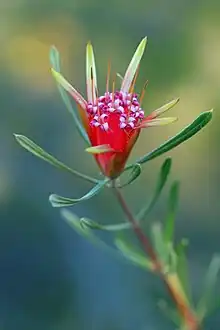
Lambertia formosa, commonly known as mountain devil, is a shrub of the family Proteaceae, endemic to New South Wales, Australia. First described in 1798 by English botanist James Edward Smith, it is the type species of the small genus Lambertia. It is generally found in heathland or open forest, growing in sandstone-based soils. It grows as a multistemmed shrub to around 2 m (7 ft) with a woody base known as a lignotuber, from which it regrows after bushfire. It has stiff narrow leaves, and the pink to red flowerheads, made up of seven individual tubular flowers, generally appear in spring and summer. It gains its common name from the horned woody follicles, which were used to make small devil-figures.
The flowers hold profuse amounts of nectar and are pollinated by honeyeaters. Although L. formosa is uncommon in cultivation, it is straightforward to grow in soils with good drainage and a partly shaded to sunny aspect. It is readily propagated by seed. Unlike all other members of the genus Lambertia, L. formosa is greatly resistant to the soil pathogen Phytophthora cinnamomi. (Full article...) Image 6
Image 6
The Eastern Suburbs & Illawarra Line (numbered T4, coloured azure blue) is a commuter railway line in the eastern and southern suburbs of Sydney and is a part of the Sydney Trains network. The line was constructed in the 1880s to Wollongong to take advantage of agricultural and mining potentials in the Illawarra area. In March 1926, it became the first railway in New South Wales to run electric train services.
Today, the railway consists of three connected lines:- The original Illawarra line from the Sydney CBD to Waterfall
- The Cronulla line from Sutherland to Cronulla, which opened in 1939 replacing an earlier tram service
- The Eastern Suburbs line from the Sydney CBD to Bondi Junction, which opened in 1979
 Image 7
Image 7 2012 Australian Paralympic Team
2012 Australian Paralympic Team
portrait of Dodd
Hannah Dodd (born 27 April 1992) is an Australian Grade IV equestrian and 1.0 point wheelchair basketball player who represented Australia in equestrian at the 2012 Summer Paralympics in London, coming 11th and 12th in her events. Switching to wheelchair basketball, she made her debut with the national team at the Osaka Cup in February 2015.
In 2008, Dodd was the Australian national Grade IV para-equestrian champion. She was runner-up in 2009, and won the Australian national championships again in 2011, along with the Oceania Championships and the National Titles team events. By 2012, she was the top-ranked Australian competitor in her event and class. (Full article...) Image 8
Image 8AtEden1903.jpg.webp) Illawarra Steam Navigation Company's SS Bega at Eden in 1903.
Illawarra Steam Navigation Company's SS Bega at Eden in 1903.
The Illawarra Steam Navigation Company was a shipping company that serviced the south coast of New South Wales, Australia from 1858 to the early 1950s. It was formed through the amalgamation of the General Steam Navigation Company, the Kiama Steam Navigation Company and the Shoalhaven Steam Navigation Company, each of whom serviced parts of the south coast with their respective vessels. After merging, the new company held a near monopoly in regard to shipping on the south coast, and their fleet visited every significant port between Sydney and the border of Victoria. The company transported both passengers and a range of produce, including livestock, and hence it became known as the 'Pig and Whistle Line': it was said that ships would wait an hour for a pig but not a minute for a passenger.
Over the years more than twenty steamships were a part of the fleet, including the 1112-ton Merimbula and the 693-ton Eden. Many of these vessels were purpose-built for the company's needs, and were constructed at shipyards both within Australia and abroad. The company's eventual demise came as a result of a number of factors, including increased competition from road and rail, the cost of replacing ships after World War II, waterfront disputes and rising costs. As a consequence, after almost 100 years in operation, the company was placed into voluntary receivership and was delisted from the stock exchange in 1955. (Full article...) Image 9Norah Head Light is an active lighthouse located at Norah Head, a headland on the Central Coast, New South Wales, Australia, close to Toukley. It is the last lighthouse of the James Barnet style to be built, and the last staffed lighthouse constructed in New South Wales.
Image 9Norah Head Light is an active lighthouse located at Norah Head, a headland on the Central Coast, New South Wales, Australia, close to Toukley. It is the last lighthouse of the James Barnet style to be built, and the last staffed lighthouse constructed in New South Wales.
Officially displayed for the first time in 1903, the original vaporized kerosene burner was upgraded in 1923, electrified in 1961 and automated and demanned in 1994, after more than 90 years of being staffed. It celebrated its centenary in 2003. (Full article...) Image 10
Image 10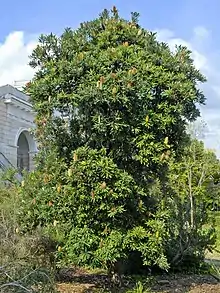 Tree of Banksia serrata at Villa Durazzo-Pallavicini
Tree of Banksia serrata at Villa Durazzo-Pallavicini
Banksia serrata, commonly known as the saw banksia, the old man banksia, the saw-tooth banksia or the red honeysuckle and as wiriyagan by the Cadigal people, is a species of woody shrub or tree of the genus Banksia, in the family Proteaceae. Native to the east coast of Australia, it is found from Queensland to Victoria with outlying populations on Tasmania and Flinders Island. Commonly growing as a gnarled tree up to 16 m (50 ft) in height, it can be much smaller in more exposed areas. This Banksia species has wrinkled grey bark, shiny dark green serrated leaves and large yellow or greyish-yellow flower spikes appearing over summer. The flower spikes, or inflorescences, turn grey as they age and pollinated flowers develop into large, grey, woody seed pods called follicles.
B. serrata is one of the four original Banksia species collected by Sir Joseph Banks in 1770, and one of four species published in 1782 as part of Carolus Linnaeus the Younger's original description of the genus. There are no recognised varieties, although it is closely related to Banksia aemula. Throughout its range, it grows exclusively in sandy soil, and is usually the dominant plant in scrubland or low woodland. B. serrata is pollinated by and provides food for a wide array of vertebrate and invertebrate animals in the autumn and winter months, and is an important source of food for honeyeaters. It is a common plant of parks and gardens. (Full article...) Image 11
Image 11 Location in The Rocks
Location in The Rocks
The Museum of Contemporary Art Australia (MCA), formerly the Museum of Contemporary Art, Sydney, is located on George Street in The Rocks neighbourhood of Sydney. The museum is housed in the Stripped Classical/Art Deco-styled former Maritime Services Board (MSB) building on the western side of Circular Quay. A modern wing was added in 2012.
While the museum as an institution was established in 1991, its roots go back a half-century earlier. Expatriate Australian artist JW Power provided for a museum of contemporary art to be established in Sydney in his 1943 will, bequeathing both money and works from his collection to the University of Sydney, his alma mater. The works, along with others acquired with the money, were exhibited mainly as a travelling collection in the decades afterward, stored in two different university buildings. This collection was known as the Power Gallery of Contemporary Art. (Full article...) Image 12
Image 12 The Glasshouse arts and entertainment centre was central to the dismissal of Port Macquarie-Hastings Council
The Glasshouse arts and entertainment centre was central to the dismissal of Port Macquarie-Hastings Council
The dismissal of the Port Macquarie-Hastings Council on 27 February 2008 marked the end of a series of events involving a project which was initiated in 2001 in the New South Wales coastal town of Port Macquarie to build a cultural and entertainment centre, known to locals as the Glasshouse. The project, initially a joint venture with the management of the neighbouring shopping centre, Port Central, was originally expected to cost the Council A$7.3 million. However, by late 2007, despite the centre not yet having opened, the costs had blown out to over A$41.7 million, with interest repayments likely to extend the council's liability to A$66 million.
On 27 July 2007, a full public inquiry was announced by the Minister for Local Government, Paul Lynch. The inquiry reported its findings in February 2008. It found that the council had failed to provide appropriate financial and project management and had lost control of the costs, that the project costs had harmed the council's ability to provide services and amenities to the community, and that the council's communications management strategy had resulted in inadequate consultation with the public and inappropriate regard to their concerns. The Minister for Local Government dismissed the council and its mayor, Rob Drew, and appointed an administrator upon receiving the inquiry's report. Drew was critical of the process throughout, maintaining that errors had been made and misinformation had been accepted as fact; however, the New South Wales Urban Task Force, a property development lobby group, believed the sacking served as a warning to other councils to stick to "core responsibilities". (Full article...) Image 13HMCS Integrity was a cutter built by the Colonial Government of New South Wales in 1804. She was the first vessel ever launched from a New South Wales dockyard and carried goods between the colony's coastal settlements of Norfolk Island, Newcastle, New South Wales, Van Diemen's Land and Port Jackson. In 1804 she took part in a series of voyages to Van Diemen's Land with the aim of founding a colony at Port Dalrymple, the site of the modern settlement of George Town, Tasmania.
Image 13HMCS Integrity was a cutter built by the Colonial Government of New South Wales in 1804. She was the first vessel ever launched from a New South Wales dockyard and carried goods between the colony's coastal settlements of Norfolk Island, Newcastle, New South Wales, Van Diemen's Land and Port Jackson. In 1804 she took part in a series of voyages to Van Diemen's Land with the aim of founding a colony at Port Dalrymple, the site of the modern settlement of George Town, Tasmania.
In 1805 Integrity encountered and recaptured a Spanish brig which had been unlawfully seized by privateers and concealed in the Kent Group of islands in Bass Strait. Having returned the Spanish vessel to colonial control, Integrity was designated the task of sailing to Chile to negotiate its return to Spain. She set sail for Valparaíso, Chile, in June 1805, but was not seen again and is likely to have foundered during the voyage. (Full article...) Image 14
Image 14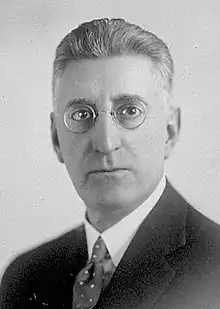 Weaver in October 1932
Weaver in October 1932
Reginald Walter Darcy Weaver (18 July 1876 – 12 November 1945) was an Australian conservative parliamentarian who served in the New South Wales Legislative Assembly for 28 years. Serving from 1917 in the backbenches, he entered the cabinet of Thomas Bavin in 1929 as Secretary for Mines and Minister for Forests until he returned to opposition in 1930. Following the success of the United Australia Party in the 1932 election, Weaver returned as the Secretary for Public Works and Minister for Health in the Stevens ministry.
In 1935 he was dropped from the ministry but was later elected as the Speaker of the New South Wales Legislative Assembly in 1937, holding office until the Mair Government lost power in 1941. Weaver then witnessed the death of the United Australia Party in 1943 and became the leader of the new Democratic Party in 1944. He was then involved in the negotiations to form the New South Wales branch of the Liberal Party, with Weaver becoming the first leader of the state Liberal Party in April 1945. He served only briefly until dying of a heart attack in November 1945. (Full article...) Image 15
Image 15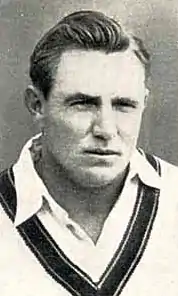 Lindwall in the late 1940s
Lindwall in the late 1940s
Raymond Russell Lindwall MBE (3 October 1921 – 23 June 1996) was an Australian cricketer who represented Australia in 61 Tests from 1946 to 1960. He is widely regarded as one of the greatest fast bowlers of all time. He also played top-flight rugby league football with St. George, appearing in two grand finals for the club before retiring to fully concentrate on Test cricket.
A right-arm fast bowler of express pace, Lindwall was widely regarded as the greatest pace bowler of his era and one of the finest of all time. He modelled his action on the great England fast bowler Harold Larwood. Together with Keith Miller, Lindwall formed a new-ball pairing regarded as one of the greatest to have played cricket. Lindwall was known for his classical style, with a smooth and rhythmic run-up and textbook side-on bowling action, from which he generated his trademark outswinger which moved away late at high pace. Lindwall mixed his outswinger with a searing yorker, subtle changes of pace and an intimidating bouncer that skidded at the heads of opposing batsmen. Later in his career, Lindwall developed an inswinger, which together with his variety, pace and control made him the most feared paceman of his time. (Full article...)
Selected image
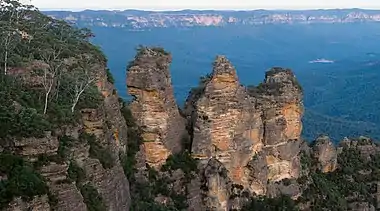
The Blue Mountains of New South Wales, Australia, are situated approximately 100 kilometres west of Sydney. They are a range of sandstone geological structures that reach to at least 1,190 metres AHD.
Related portals

(Northern
Territory) |
WikiProjects
| WikiProject New South Wales | WikiProject Australia |
Selected articles -
 Image 1The Murray River (in South Australia: River Murray) (Ngarrindjeri: Millewa, Yorta Yorta: Dhungala (Tongala)) is a river in Southeastern Australia. It is Australia's longest river at 2,508 km (1,558 mi) extent. Its tributaries include five of the next six longest rivers of Australia (the Murrumbidgee, Darling, Lachlan, Warrego and Paroo Rivers). Together with that of the Murray, the catchments of these rivers form the Murray–Darling basin, which covers about one-seventh the area of Australia. It is widely considered Australia's most important irrigated region.
Image 1The Murray River (in South Australia: River Murray) (Ngarrindjeri: Millewa, Yorta Yorta: Dhungala (Tongala)) is a river in Southeastern Australia. It is Australia's longest river at 2,508 km (1,558 mi) extent. Its tributaries include five of the next six longest rivers of Australia (the Murrumbidgee, Darling, Lachlan, Warrego and Paroo Rivers). Together with that of the Murray, the catchments of these rivers form the Murray–Darling basin, which covers about one-seventh the area of Australia. It is widely considered Australia's most important irrigated region.
The Murray rises in the Australian Alps, draining the western side of Australia's highest mountains, then meanders northwest across Australia's inland plains, forming the border between the states of New South Wales and Victoria as it flows into South Australia. From an east–west direction it turns south at Morgan for its final 315 km (196 mi), reaching the eastern edge of Lake Alexandrina, which fluctuates in salinity. The water then flows through several channels around Hindmarsh Island and Mundoo Island. There it is joined by lagoon water from The Coorong to the south-east before emptying into the Great Australian Bight (often referenced on Australian maps as the Southern Ocean) through the Murray Mouth, 10 km (6.2 mi) east of Goolwa South. Despite discharging considerable volumes of water at times, particularly before the advent of large-scale river regulation, the waters at the Murray Mouth are almost invariably slow and shallow. (Full article...) Image 2The Silverton Wind Farm is a 199 megawatt wind farm situated on the Barrier Ranges in New South Wales, built for AGL Energy by CATCON and General Electric.
Image 2The Silverton Wind Farm is a 199 megawatt wind farm situated on the Barrier Ranges in New South Wales, built for AGL Energy by CATCON and General Electric.
On 3 June 2009, the project was approved by the NSW state Government. (Full article...) Image 3
Image 3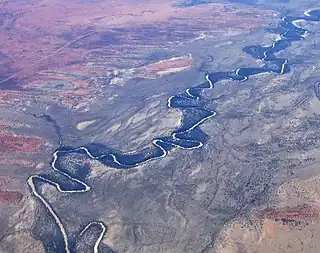 Aerial view of the Darling River near Menindee
Aerial view of the Darling River near Menindee
The Darling River (Paakantyi: Baaka or Barka) is the third-longest river in Australia, measuring 1,472 kilometres (915 mi) from its source in northern New South Wales to its confluence with the Murray River at Wentworth. Including its longest contiguous tributaries it is 2,844 km (1,767 mi) long, making it the longest river system in Australia. The Darling River is the outback's most famous waterway.
The Darling is in poor health, suffering from over-allocation of its waters to irrigation, pollution from pesticide runoff, and prolonged drought. During drought periods in 2019 it barely flowed at all. The river has a high salt content and declining water quality. Increased rainfall in its catchment in 2010 improved its flow, but the health of the river will depend on long-term management. (Full article...) Image 4
Image 4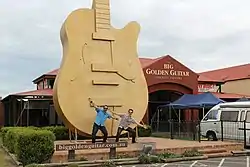
The Big Golden Guitar is one of the many "big" attractions that can be found around Australia. Located in Tamworth, New South Wales, the monument is one of the best-known points of interest in New England.
It is also a major attraction during the Tamworth Country Music Festival. (Full article...) Image 5
Image 5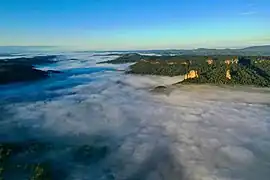 The Nimbin Valley and Nimbin Rocks in the Northern Rivers of NSW (aerial shot)
The Nimbin Valley and Nimbin Rocks in the Northern Rivers of NSW (aerial shot)
Nimbin is a town in the Northern Rivers area of the Australian state of New South Wales, approximately 30 km (19 mi) north of Lismore, 33 km (21 mi) northeast of Kyogle, and 70 km (43 mi) west of Byron Bay.
Nimbin is notable for the prominence of its environmental initiatives such as permaculture, sustainability, and self-sufficiency, as well as the cannabis counterculture. Writer Austin Pick described his initial impressions of the village this way: "It is as if a smoky avenue of Amsterdam has been placed in the middle of the mountains behind frontier-style building facades. ... Nimbin is a strange place indeed." (Full article...) Image 6The history of New South Wales refers to the history of the Australian state of New South Wales and the area's preceding Indigenous and British colonial societies. The Mungo Lake remains indicate occupation of parts of the New South Wales area by Indigenous Australians for at least 40,000 years. The British navigator James Cook became the first European to map the coast in 1770 and a First Fleet of British convicts followed to establish a penal colony at Sydney in 1788.
Image 6The history of New South Wales refers to the history of the Australian state of New South Wales and the area's preceding Indigenous and British colonial societies. The Mungo Lake remains indicate occupation of parts of the New South Wales area by Indigenous Australians for at least 40,000 years. The British navigator James Cook became the first European to map the coast in 1770 and a First Fleet of British convicts followed to establish a penal colony at Sydney in 1788.
The colony established an autonomous parliamentary democracy from the 1850s and became a state of the Commonwealth of Australia in 1901 following a vote to federate with the other British colonies of Australia. Through the 20th century, the state was a major destination for an increasingly diverse collection of migrants from many nations. In the 21st century, the state is the most populous in Australia, and its capital, Sydney is a major financial capital and host to international cultural and economic events. (Full article...) Image 7
Image 7_Johnsons_Building.JPG.webp) Johnson's Building, pictured in 2010
Johnson's Building, pictured in 2010
Johnson's Building is a heritage-listed former retail stores and now stock exchange offices, bar and restaurant located at 233–235 George Street in the inner city Sydney suburb of The Rocks in the City of Sydney local government area of New South Wales, Australia. It was designed by Walter Liberty Vernon and built in 1912. It is also known as Chamber of Commerce Building and Johnson's Overalls Building (Johnsons). The property is owned by Property NSW, an agency of the Government of New South Wales. It was added to the New South Wales State Heritage Register on 10 May 2002. (Full article...) Image 8Sport in New South Wales describes participation in and attendance at organised sports events in the state of New South Wales in Australia. Sport forms an integral part of the culture of the state.
Image 8Sport in New South Wales describes participation in and attendance at organised sports events in the state of New South Wales in Australia. Sport forms an integral part of the culture of the state.
New South Wales has attracted many international multi-sport events including the 2000 Summer Olympics, held in Sydney. There are many professional sporting teams in New South Wales. The biggest sport in the state by a wide margin is rugby league, in which the state has 10 professional clubs in the National Rugby League. Other popular spectator sports include rugby union, cricket, Australian rules football and soccer. In terms of participation, the most popular sports in the state are netball, tennis, soccer, rugby league and touch football. (Full article...) Image 9
Image 9
Tooth and Co was the major brewer of beer in New South Wales, Australia. The company owned a large brewery on Broadway in Sydney from 1835 until 1985, known as the Kent Brewery. It was historically one of Australia's oldest companies, having been established as a partnership in 1835 and listed on the then Sydney Stock Exchange in July 1961. The brand has undergone a revival in 2015. (Full article...) Image 10
Image 10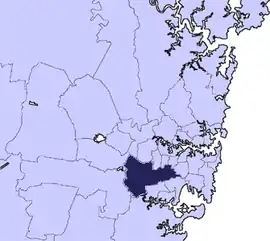 Location of Canterbury-Bankstown in Sydney area
Location of Canterbury-Bankstown in Sydney area
Canterbury-Bankstown Council, trading as the City of Canterbury Bankstown, is a local government area located in the South Western region of Sydney, New South Wales, Australia. The council was formed on 12 May 2016 from a merger of the City of Canterbury and the City of Bankstown, after a review of local government in New South Wales by the state government. The eastern portion of the council that was once City of Canterbury falls within the northern portion of The Parish of St George above Wolli Creek and The M5 but below The Cooks River.
The City of Canterbury Bankstown comprises an area of 110.8 square kilometres (42.8 sq mi) and as per the 2021 census, had a population of 410,419 making it the second most populous local government area in New South Wales. (Full article...) Image 11
Image 11 Aerial view across the mouth of the Parramatta River as it reaches in Port Jackson, looking east towards downtown Sydney
Aerial view across the mouth of the Parramatta River as it reaches in Port Jackson, looking east towards downtown Sydney
The Parramatta River is an intermediate tide-dominated, drowned valley estuary located in Sydney, New South Wales, Australia. With an average depth of 5.1 metres (17 ft), the Parramatta River is the main tributary of Sydney Harbour, a branch of Port Jackson. Secondary tributaries include the smaller Lane Cove and Duck rivers.
Formed by the confluence of Toongabbie Creek and Darling Mills Creek at North Parramatta, the river flows in an easterly direction to a line between Yurulbin in Birchgrove and Manns Point in Greenwich. Here it flows into Port Jackson, about 21 kilometres (13 mi) from the Tasman Sea. The total catchment area of the river is approximately 252.4 square kilometres (97.5 sq mi) and is tidal to Charles Street Weir in Parramatta, approximately 30 kilometres (19 mi) from the Sydney Heads. (Full article...) Image 12
Image 12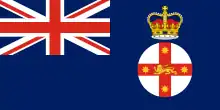 Standard of the Governor
Standard of the Governor
The governor of New South Wales is the viceregal representative of the Australian monarch, King Charles III, in the state of New South Wales. In an analogous way to the governor-general of Australia at the national level, the governors of the Australian states perform constitutional and ceremonial functions at the state level. The governor is appointed by the monarch on the advice of the premier of New South Wales, and serves in office for an unfixed period of time—known as serving At His Majesty's pleasure—though five years is the general standard of office term. The current governor is retired jurist Margaret Beazley, who succeeded David Hurley on 2 May 2019.
The office has its origin in the 18th-century colonial governors of New South Wales upon its settlement in 1788, and is the oldest continuous institution in Australia. The present incarnation of the position emerged with the Federation of Australia and the New South Wales Constitution Act 1902, which defined the viceregal office as the governor acting by and with the advice of the Executive Council of New South Wales. However, the post still ultimately represented the government of the United Kingdom until, after continually decreasing involvement by the British government, the passage in 1942 of the Statute of Westminster Adoption Act 1942 (see Statute of Westminster) and the Australia Act 1986, after which the governor became the direct, personal representative of the Australian sovereign. (Full article...) Image 13
Image 13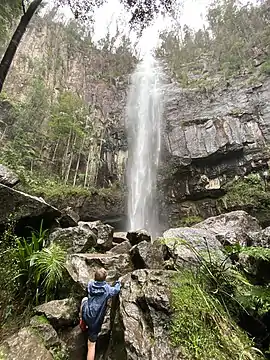 Protesters Falls in the ancient rainforest of Nightcap National Park
Protesters Falls in the ancient rainforest of Nightcap National Park
The Nightcap National Park is a national park situated within the Nightcap Range in the Northern Rivers region of New South Wales, Australia. The 8,080-hectare (20,000-acre) park was created in April 1983 and is situated 35 kilometres (22 mi) north of Lismore. The park was established following campaigns and blockades against logging at Terania Creek, Grier's Scrub and Mount Nardi between 1979 and 1982. Sections of the Whian Whian state forest were added to it following blockading and campaigning in 1998. The national park is classed by the IUCN World Commission on Protected Areas as Category II and is part of the Shield Volcano Group of the World Heritage Site Gondwana Rainforests of Australia inscribed in 1986 and added to the Australian National Heritage List in 2007. (Full article...) Image 14
Image 14 Map of rail lines in NSW
Map of rail lines in NSW
The Australian state of New South Wales has an extensive network of railways, which were integral to the growth and development of the state. The vast majority of railway lines were government built and operated, but there were also several private railways, some of which operate to this day. (Full article...) Image 15
Image 15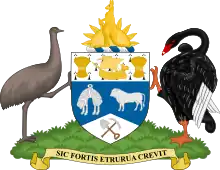 Coat of Arms, granted in 1931.
Coat of Arms, granted in 1931.
The Bank of New South Wales (BNSW), also known commonly as The Wales, was the first bank in Australia, being established in Sydney in 1817 and situated on Broadway. During the 19th century, the bank opened branches throughout Australia and New Zealand, expanding into Oceania in the 20th century. It merged with many other financial institutions, finally merging with the Commercial Bank of Australia in 1982 and being renamed to the Westpac Banking Corporation on 4 May that year under the Bank of New South Wales (Change of Name) Act 1982. (Full article...)
Did you know (auto-generated)
- ... that Victorian post office official William Rundell also collected stamps in his spare time, acquiring 48 copies of the "Sydney view" stamps of New South Wales?
- ... that the "Cuddle with a Koala" experience at Featherdale Wildlife Park was stopped in 1988 when New South Wales law was changed to restrict koala handling?
- ... that at the time of her death at age 90, Lilliane Brady was the mayor of Cobar Shire and the longest-serving female mayor in New South Wales's history?
- ... that Mary Kate Barlow was made a dame of the Holy Sepulchre in recognition of her contribution to the Eucharistic congress of 1928 held in Sydney, Australia?
General images -

 Image 2Olympic colours on the Sydney Harbour Bridge in the year 2000 (from History of New South Wales)
Image 2Olympic colours on the Sydney Harbour Bridge in the year 2000 (from History of New South Wales)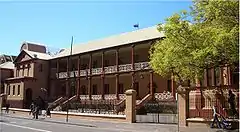 Image 3The New South Wales Parliament is Australia's oldest parliament. (from History of New South Wales)
Image 3The New South Wales Parliament is Australia's oldest parliament. (from History of New South Wales).jpg.webp) Image 4Dry paddocks in the Riverina region during the 2007 drought (from History of New South Wales)
Image 4Dry paddocks in the Riverina region during the 2007 drought (from History of New South Wales) Image 5Sir Henry Parkes was a Premier of New South Wales and one of the "Fathers of Australian Federation" (from History of New South Wales)
Image 5Sir Henry Parkes was a Premier of New South Wales and one of the "Fathers of Australian Federation" (from History of New South Wales)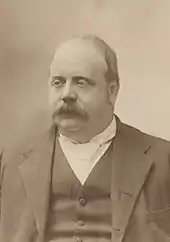 Image 6Sir George Reid was Premier of New South Wales in the lead up to Federation. (from History of New South Wales)
Image 6Sir George Reid was Premier of New South Wales in the lead up to Federation. (from History of New South Wales)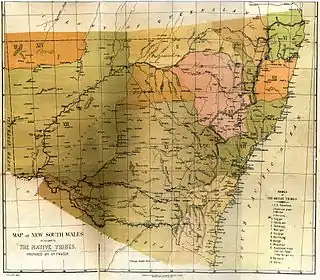
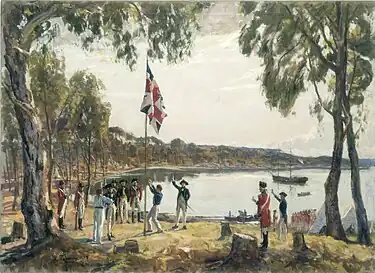 Image 8Governor Arthur Phillip hoists the British flag over the new colony at Sydney in 1788 (from History of New South Wales)
Image 8Governor Arthur Phillip hoists the British flag over the new colony at Sydney in 1788 (from History of New South Wales)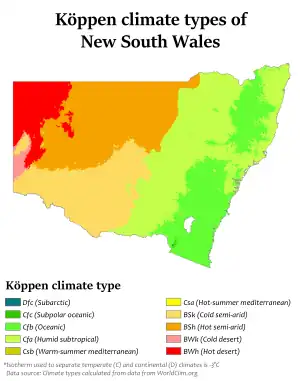
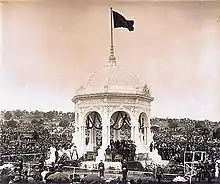 Image 10Federation Pavilion, Centennial Park, Sydney, 1 January 1901. (from History of New South Wales)
Image 10Federation Pavilion, Centennial Park, Sydney, 1 January 1901. (from History of New South Wales)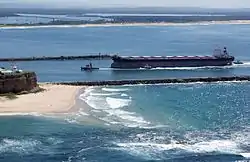 Image 11A bulk carrier entering the Port of Newcastle, New South Wales, 2009 (from Economy of New South Wales)
Image 11A bulk carrier entering the Port of Newcastle, New South Wales, 2009 (from Economy of New South Wales).jpg.webp) Image 12Landing of Lieutenant James Cook at Botany Bay, 29 April 1770 (from History of New South Wales)
Image 12Landing of Lieutenant James Cook at Botany Bay, 29 April 1770 (from History of New South Wales)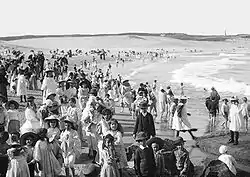
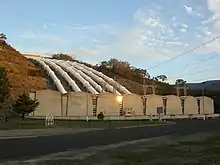 Image 14Tumut 3 Power Station was constructed as part of the vast Snowy Mountains Scheme in New South Wales (1949–1974). Construction necessitated the expansion of Australia's immigration program. (from History of New South Wales)
Image 14Tumut 3 Power Station was constructed as part of the vast Snowy Mountains Scheme in New South Wales (1949–1974). Construction necessitated the expansion of Australia's immigration program. (from History of New South Wales)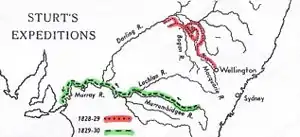
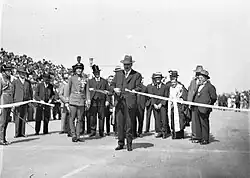 Image 16Ribbon ceremony to open the Sydney Harbour Bridge on 20 March 1932. Breaking protocol, the soon to be dismissed Premier Jack Lang cuts the ribbon while Governor Philip Game looks on. (from History of New South Wales)
Image 16Ribbon ceremony to open the Sydney Harbour Bridge on 20 March 1932. Breaking protocol, the soon to be dismissed Premier Jack Lang cuts the ribbon while Governor Philip Game looks on. (from History of New South Wales)
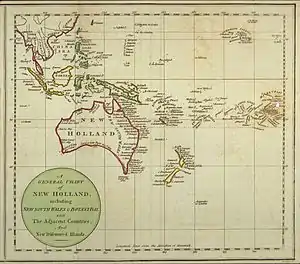 Image 18A General Chart of New Holland including New South Wales & Botany Bay with The Adjacent Countries and New Discovered Lands, published in An Historical Narrative of the Discovery of New Holland and New South Wales, London, Fielding and Stockdale, November 1786 (from History of New South Wales)
Image 18A General Chart of New Holland including New South Wales & Botany Bay with The Adjacent Countries and New Discovered Lands, published in An Historical Narrative of the Discovery of New Holland and New South Wales, London, Fielding and Stockdale, November 1786 (from History of New South Wales) Image 19The 5th Governor of New South Wales, Lachlan Macquarie, was influential in establishing civil society in Australia (from History of New South Wales)
Image 19The 5th Governor of New South Wales, Lachlan Macquarie, was influential in establishing civil society in Australia (from History of New South Wales)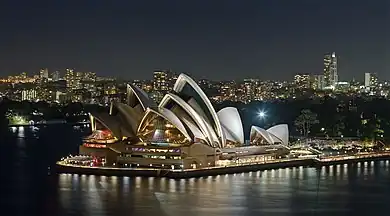
 Image 21Hyde Park, Sydney with the Australian Museum under construction in the distance, 1842 (from History of New South Wales)
Image 21Hyde Park, Sydney with the Australian Museum under construction in the distance, 1842 (from History of New South Wales) Image 22A chart of part of the interior of New South Wales by John Oxley, Surveyor General, 1822 (from History of New South Wales)
Image 22A chart of part of the interior of New South Wales by John Oxley, Surveyor General, 1822 (from History of New South Wales)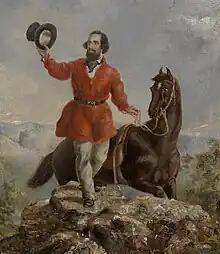 Image 23Mr E.H. Hargraves, The Gold Discoverer of Australia, returning the salute of the gold miners - Thomas Tyrwhitt Balcombe, 1851 (from History of New South Wales)
Image 23Mr E.H. Hargraves, The Gold Discoverer of Australia, returning the salute of the gold miners - Thomas Tyrwhitt Balcombe, 1851 (from History of New South Wales) Image 24World leaders with Prime Minister John Howard in Sydney for the 2007 APEC conference (from History of New South Wales)
Image 24World leaders with Prime Minister John Howard in Sydney for the 2007 APEC conference (from History of New South Wales)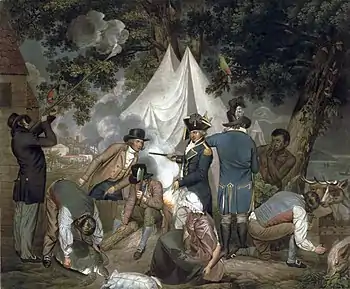 Image 25Founding of the settlement of Port Jackson at Botany Bay in New South Wales in 1788 - Thomas Gosse (from History of New South Wales)
Image 25Founding of the settlement of Port Jackson at Botany Bay in New South Wales in 1788 - Thomas Gosse (from History of New South Wales)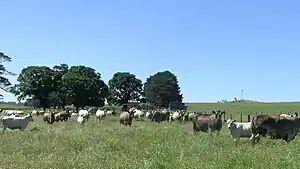
 Image 27Japanese POW camp at Cowra, shortly before the Cowra breakout (from History of New South Wales)
Image 27Japanese POW camp at Cowra, shortly before the Cowra breakout (from History of New South Wales)
Topics
Categories
More portals
In the news
- 10 November 2023 –
- Logistics company DP World, which accounts for around 40% of Australia's freight transport, suspends operations at four ports in Brisbane, Fremantle, Melbourne, and Sydney, after a cyberattack was reported, which federal police is investigating. (The Independent)
Associated Wikimedia
The following Wikimedia Foundation sister projects provide more on this subject:
-
 Commons
Commons
Free media repository -
 Wikibooks
Wikibooks
Free textbooks and manuals -
 Wikidata
Wikidata
Free knowledge base -
 Wikinews
Wikinews
Free-content news -
 Wikiquote
Wikiquote
Collection of quotations -
 Wikisource
Wikisource
Free-content library -
 Wikiversity
Wikiversity
Free learning tools -
 Wikivoyage
Wikivoyage
Free travel guide -
 Wiktionary
Wiktionary
Dictionary and thesaurus
-
 List of all portalsList of all portals
List of all portalsList of all portals -
 The arts portal
The arts portal -
 Biography portal
Biography portal -
 Current events portal
Current events portal -
 Geography portal
Geography portal -
 History portal
History portal -
 Mathematics portal
Mathematics portal -
 Science portal
Science portal -
 Society portal
Society portal -
 Technology portal
Technology portal -
 Random portalRandom portal
Random portalRandom portal -
 WikiProject PortalsWikiProject Portals
WikiProject PortalsWikiProject Portals
